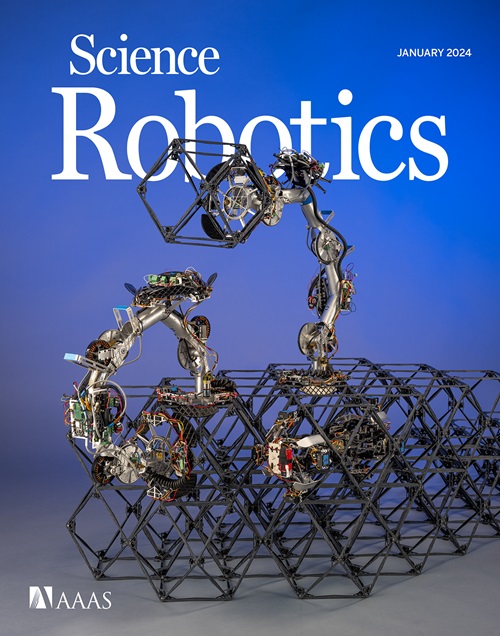ANYmal 跑酷:学习四足机器人的敏捷导航
IF 26.1
1区 计算机科学
Q1 ROBOTICS
引用次数: 0
摘要
使用四足机器人进行敏捷导航是一项极具挑战性的任务,因为机器人的运动具有高度动态性,会与机器人的各个部分发生接触,而且感知传感器的视野有限。在这里,我们提出了一种完全学习的方法来训练此类机器人,征服那些让人联想到跑酷挑战的场景。该方法包括针对几种类型的障碍物训练高级运动技能,如行走、跳跃、攀爬和蹲伏,然后使用高级策略在地形中选择和控制这些技能。得益于我们的分层表述,导航策略能够意识到每种技能的能力,并根据手头的场景调整自己的行为。此外,我们还训练了一个感知模块,以从高度遮蔽和嘈杂的感知数据中重建障碍物,并赋予管道以场景理解能力。与之前的尝试相比,我们的方法无需专家论证、离线计算、环境先验知识或明确考虑接触,就能为具有挑战性的场景规划路径。虽然这些模块只是通过模拟数据训练出来的,但我们的实际实验证明了在硬件上的成功移植,机器人以每秒 2 米的速度导航并穿越连续的高难度障碍物。本文章由计算机程序翻译,如有差异,请以英文原文为准。
ANYmal parkour: Learning agile navigation for quadrupedal robots
Performing agile navigation with four-legged robots is a challenging task because of the highly dynamic motions, contacts with various parts of the robot, and the limited field of view of the perception sensors. Here, we propose a fully learned approach to training such robots and conquer scenarios that are reminiscent of parkour challenges. The method involves training advanced locomotion skills for several types of obstacles, such as walking, jumping, climbing, and crouching, and then using a high-level policy to select and control those skills across the terrain. Thanks to our hierarchical formulation, the navigation policy is aware of the capabilities of each skill, and it will adapt its behavior depending on the scenario at hand. In addition, a perception module was trained to reconstruct obstacles from highly occluded and noisy sensory data and endows the pipeline with scene understanding. Compared with previous attempts, our method can plan a path for challenging scenarios without expert demonstration, offline computation, a priori knowledge of the environment, or taking contacts explicitly into account. Although these modules were trained from simulated data only, our real-world experiments demonstrate successful transfer on hardware, where the robot navigated and crossed consecutive challenging obstacles with speeds of up to 2 meters per second.
求助全文
通过发布文献求助,成功后即可免费获取论文全文。
去求助
来源期刊

Science Robotics
Mathematics-Control and Optimization
CiteScore
30.60
自引率
2.80%
发文量
83
期刊介绍:
Science Robotics publishes original, peer-reviewed, science- or engineering-based research articles that advance the field of robotics. The journal also features editor-commissioned Reviews. An international team of academic editors holds Science Robotics articles to the same high-quality standard that is the hallmark of the Science family of journals.
Sub-topics include: actuators, advanced materials, artificial Intelligence, autonomous vehicles, bio-inspired design, exoskeletons, fabrication, field robotics, human-robot interaction, humanoids, industrial robotics, kinematics, machine learning, material science, medical technology, motion planning and control, micro- and nano-robotics, multi-robot control, sensors, service robotics, social and ethical issues, soft robotics, and space, planetary and undersea exploration.
 求助内容:
求助内容: 应助结果提醒方式:
应助结果提醒方式:


